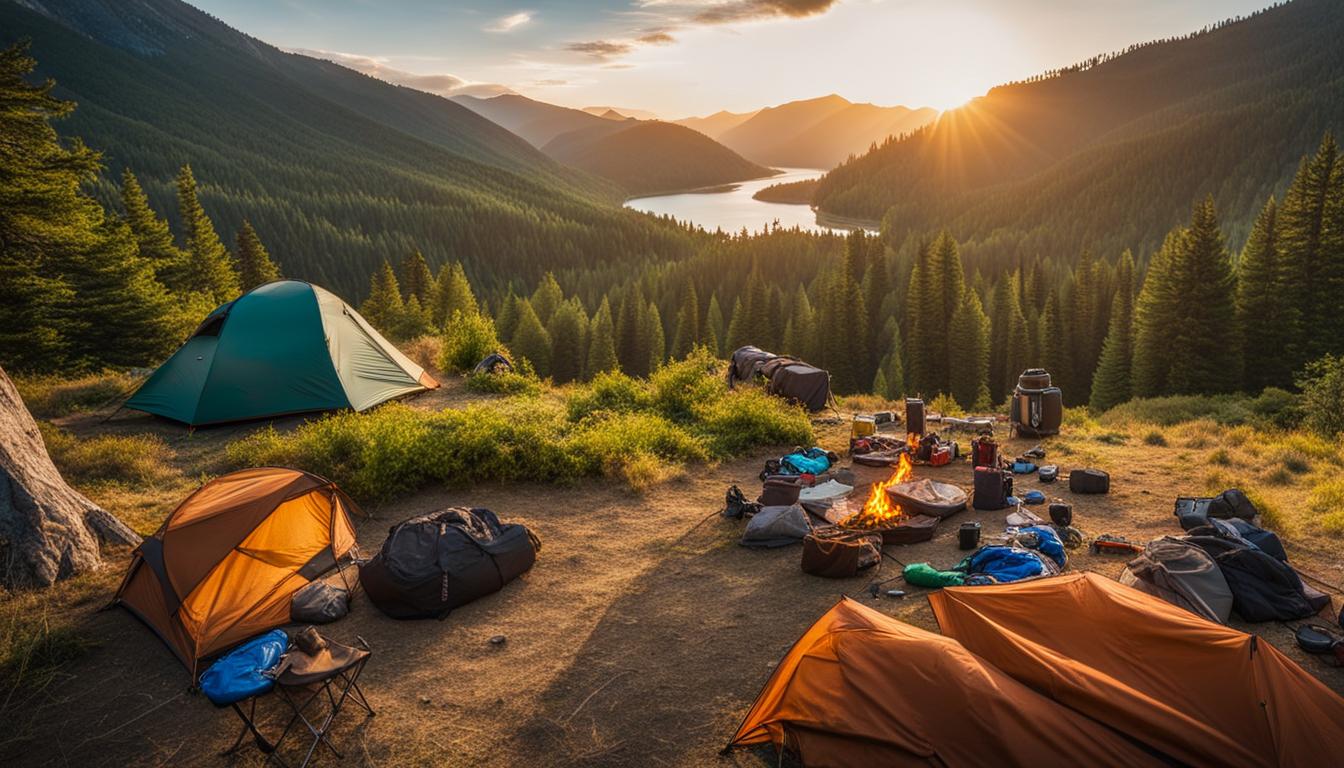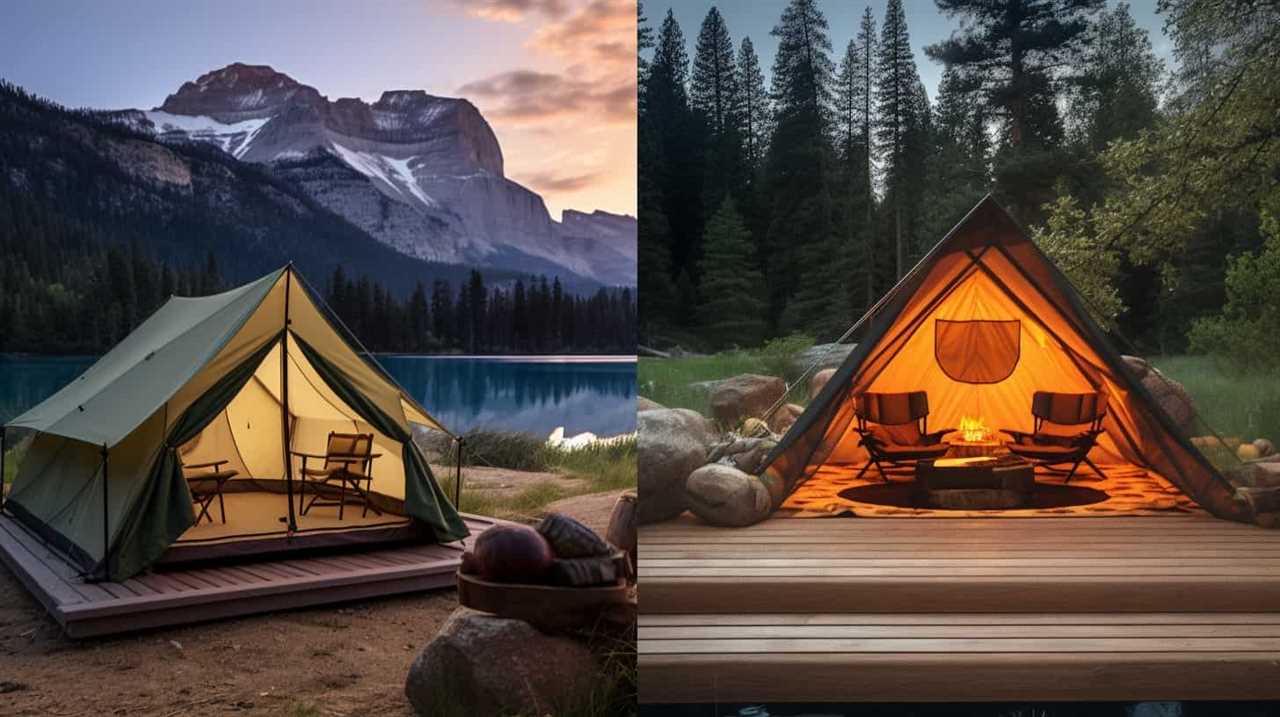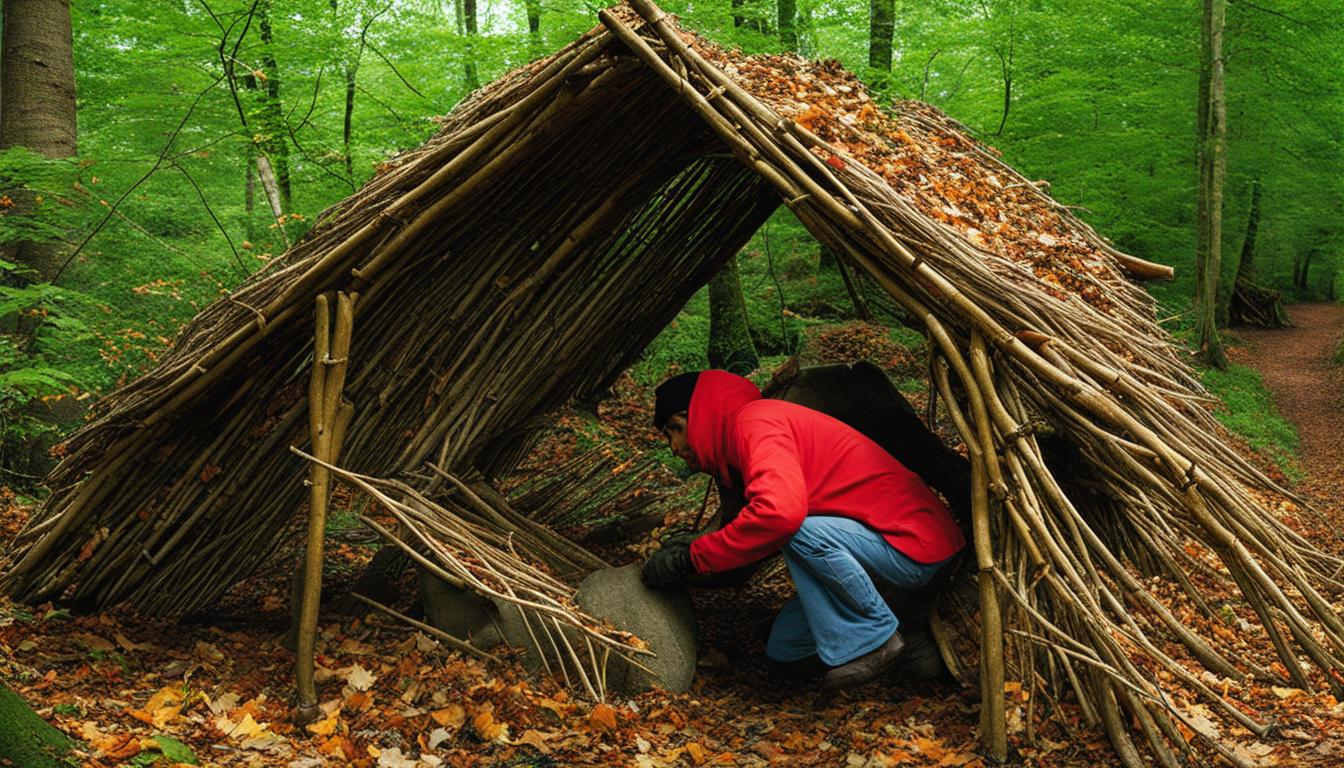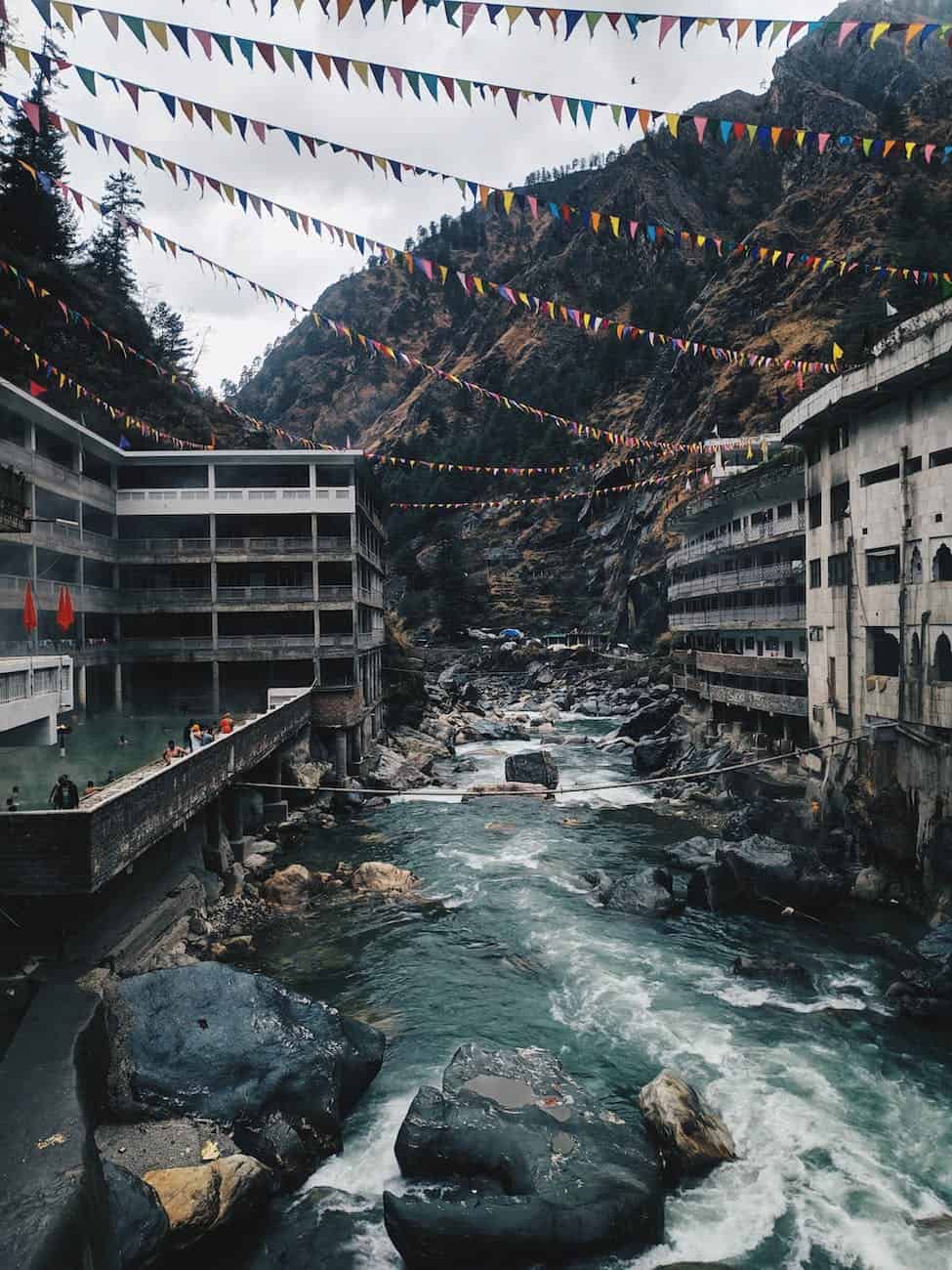Are you preparing for a camping trip? Whether you are experienced with outdoor activities or new to camping, having some essential tips and tricks can greatly enhance your experience. From packing the necessary gear to ensuring your safety in the wilderness, we have put together a list of camping essentials that will guarantee your next adventure is memorable.
Before you embark on your camping journey, take a moment to familiarize yourself with these important camping tips:
Key Takeaways:
- Make a camping checklist of essential gear before your trip.
- Ensure a good night’s sleep with high-quality sleeping gear.
- Pack the right cooking gear and delicious recipes for tasty meals under the stars.
- Dress appropriately for outdoor activities and changing weather conditions.
- Maintain hygiene and carry a first aid kit for health and safety.
With these camping tips in mind, you’ll be well-prepared to embark on an amazing outdoor adventure. So, grab your gear, embrace the beauty of nature, and create unforgettable memories on your next camping trip!
Start Planning and Getting Ready Ahead of Time
When it comes to camping, preparation is key. To ensure a successful and stress-free trip, it’s important to start planning and getting ready ahead of time. By creating a camping checklist and making sure all your gear is packed and ready to go, you can set yourself up for a smooth and enjoyable adventure in the great outdoors.
Gather Your Camping Essentials
Before heading out, it’s crucial to have all the necessary camping gear on hand. Make a checklist of items such as a tent, sleeping bags, camping chairs, cooking equipment, and lighting sources. Don’t forget to pack essentials like a first aid kit, insect repellent, and sunscreen to ensure your safety and well-being during the trip.
Double-Check Your List
Once you’ve gathered all your camping gear, take some time to double-check your checklist. Make sure you haven’t overlooked any important items and that everything is in working order. This includes setting up your tent beforehand to make sure all the parts are intact and that you know how to properly pitch and secure it.
Plan for Meals and Snacks
One aspect of camping that often gets overlooked is meal planning. Before your trip, plan out your meals and snacks for each day. This will help you avoid any last-minute scrambling for food and ensure that you have all the necessary ingredients and cooking utensils. Consider prepping some meals ahead of time to make cooking at the campsite easier and more convenient.
| Essential Camping Gear Checklist | |
|---|---|
| Tent | |
| Sleeping bags | |
| Camping chairs | |
| Cooking equipment | |
| Lighting sources | |
| First aid kit | |
| Insect repellent | |
| Sunscreen |
By starting your planning and preparation ahead of time, you can ensure that you have everything you need for a successful camping trip. Remember to check and double-check your checklist, plan out your meals and snacks, and have all your gear in working order. With a well-prepared approach, you’ll be ready to fully enjoy your outdoor adventure.
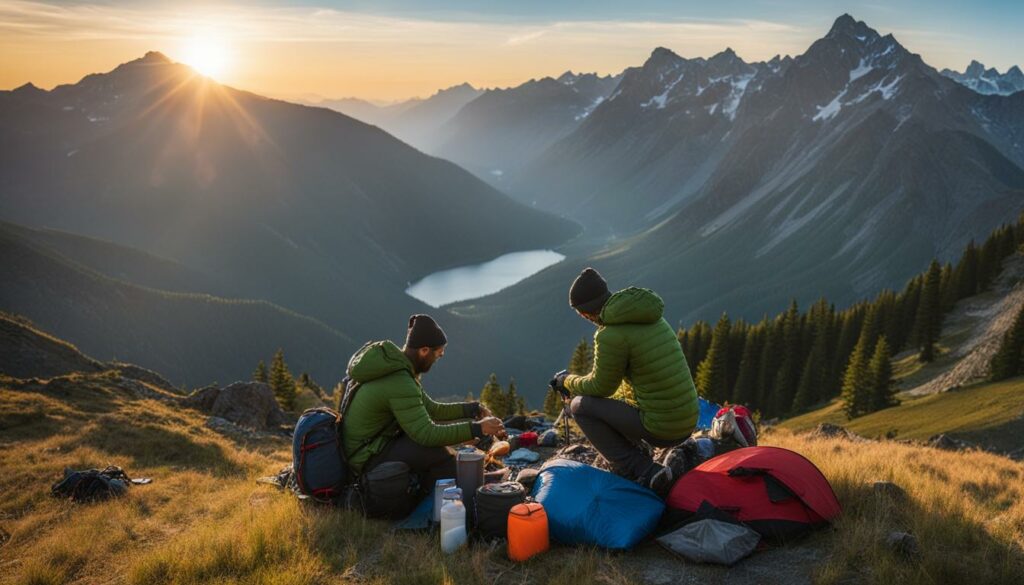
Ensure Quality Sleep
Getting a good night’s sleep is essential for a successful camping trip. After a day of outdoor activities, you’ll want to rest and recharge in a comfortable sleeping environment. Here are some tips to ensure quality sleep during your camping adventure.
Choose the Right Camping Gear
The key to a restful sleep starts with choosing the right camping gear. Invest in a high-quality tent that provides proper insulation and protection from the elements. Look for a tent that is spacious enough to accommodate you and your camping companions comfortably. Additionally, consider the season and weather conditions when selecting a sleeping bag. Opt for a sleeping bag with the appropriate temperature rating to keep you warm and cozy throughout the night.
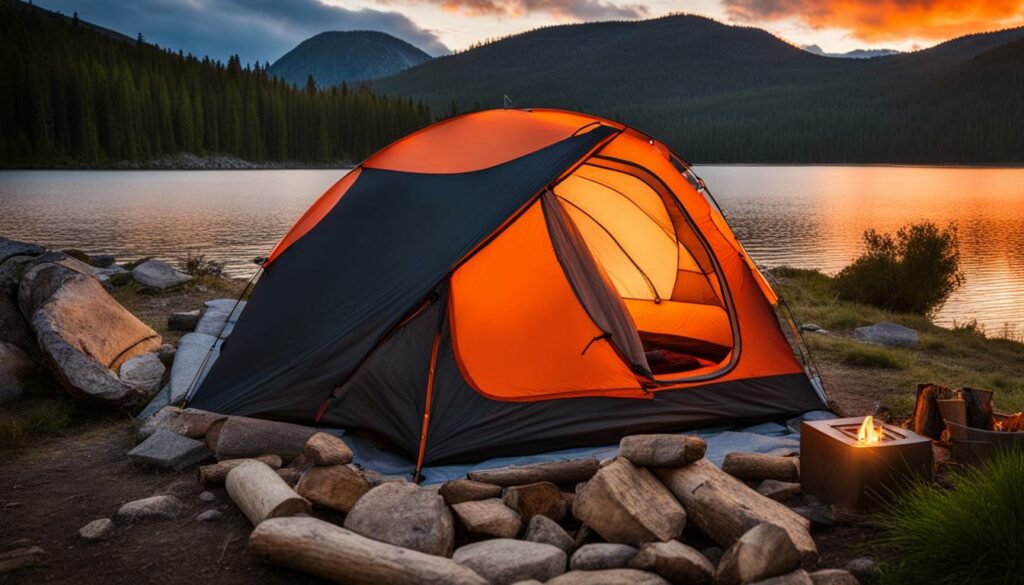
Create a Comfortable Sleeping Surface
In addition to a good tent and sleeping bag, creating a comfortable sleeping surface is crucial for quality sleep. Invest in a sleeping pad or cot to provide insulation from the ground and cushioning for your body. The type of sleeping surface you choose will depend on your personal preference and camping style. Some campers prefer the convenience and comfort of an inflatable air mattress, while others prefer the simplicity of a foam sleeping pad. Consider your needs and comfort level when selecting the right sleeping surface for your camping trip.
Establish a Bedtime Routine
Establishing a bedtime routine can help signal to your body that it’s time to wind down and relax. Disconnect from electronic devices at least an hour before bedtime to promote better sleep. Engage in calming activities such as reading a book, practicing relaxation techniques, or stargazing. Additionally, consider using earplugs or a sleep mask if you’re sensitive to noise or light in the camping environment. Creating a peaceful and comfortable sleep environment will enhance your overall camping experience.
| Sleeping Tips | Benefits |
|---|---|
| Choose the right camping gear | Ensures insulation and protection |
| Create a comfortable sleeping surface | Provides cushioning and insulation from the ground |
| Establish a bedtime routine | Promotes relaxation and signals the body to sleep |
Pack the Right Camping Gear for Cooking
When it comes to camping, one of the highlights is undoubtedly the delicious meals you can prepare outdoors. To make sure you have a successful culinary adventure, it’s crucial to pack the right camping cooking gear. Here are some essential items to consider:
- Camping stove: A portable camping stove is a must-have for cooking meals in the great outdoors. Look for a lightweight and compact option that is easy to use and fuels with propane or butane.
- Cooking utensils: Don’t forget to pack a set of cooking utensils, including a spatula, tongs, and a cooking spoon. These will come in handy when preparing meals over the campfire or on the camping stove.
- Pots and pans: Bring a selection of pots and pans in different sizes to accommodate various cooking needs. Opt for non-stick options, as they are easier to clean and maintain.
- Cooler: Keep your perishable food items fresh by packing them in a reliable cooler. Look for a cooler with insulation to maintain the desired temperature and consider using ice packs or frozen water bottles to keep everything cold.
- Tableware: Don’t forget to bring plates, bowls, cups, and utensils for enjoying your meals. Consider using reusable options to minimize waste and environmental impact.
Now that you have the essential camping cooking gear, it’s time to plan your camping meals. Here are a few ideas to get you started:
- Campfire classics: Nothing beats the taste of traditional campfire meals like roasted marshmallows, hot dogs, and foil-wrapped potatoes. These simple yet delicious options are perfect for camping.
- One-pot wonders: Prepare hearty and flavorful one-pot meals that require minimal cleanup. Options like chili, pasta dishes, and stir-fries can be easily cooked in a single pot or skillet.
- Grilled delights: Grilling is a favorite camping cooking method. Bring along some marinated meats, vegetables, and skewers to enjoy a tasty and healthy grilled feast.
Pro tip: Prepping meals in advance and using pre-cut ingredients can save you time and effort at the campsite.
With the right camping cooking gear and delicious recipes, you can enjoy satisfying meals in the great outdoors. Remember to follow proper food safety practices and clean up thoroughly after cooking. Happy camping and bon appétit!

Dress Appropriately for Outdoor Activities
When it comes to camping, dressing appropriately for outdoor activities is essential for a comfortable and enjoyable experience. Whether you’re hiking through rugged terrain or lounging by the campfire, having the right clothing and footwear can make all the difference. Here are some tips to help you dress for camping success.
Pack Layered Clothing
One of the key elements of dressing for camping is layering your clothing. This allows you to adjust your outfit according to the weather and your activity level. Start with a moisture-wicking base layer to keep you dry and comfortable. Then add insulating layers such as fleece or down jackets to trap warmth. Finally, top it off with a waterproof and breathable outer shell to protect you from wind and rain.
Choose Appropriate Footwear
Having the right footwear is crucial for navigating the outdoors. Opt for sturdy hiking boots that provide ankle support and traction. They should be comfortable and broken in before your camping trip to prevent blisters and discomfort. Remember to pack extra pairs of socks to keep your feet dry and prevent odors.
Consider the Weather
Before you pack your camping wardrobe, take into account the weather conditions of your destination. If you’re expecting hot and sunny weather, pack lightweight and breathable clothing to stay cool. On the other hand, if you’re camping in colder temperatures, make sure to bring warm layers, including hats and gloves, to stay insulated. Always check the weather forecast before you leave to make appropriate clothing choices.
| Essential Clothing Items for Camping | Recommended Brands |
|---|---|
| Moisture-wicking base layer | Patagonia, Smartwool, Icebreaker |
| Fleece or down jacket | The North Face, Columbia, Arc’teryx |
| Waterproof outer shell | Marmot, Outdoor Research, Gore-Tex |
| Hiking boots | Merrell, Salomon, Keen |
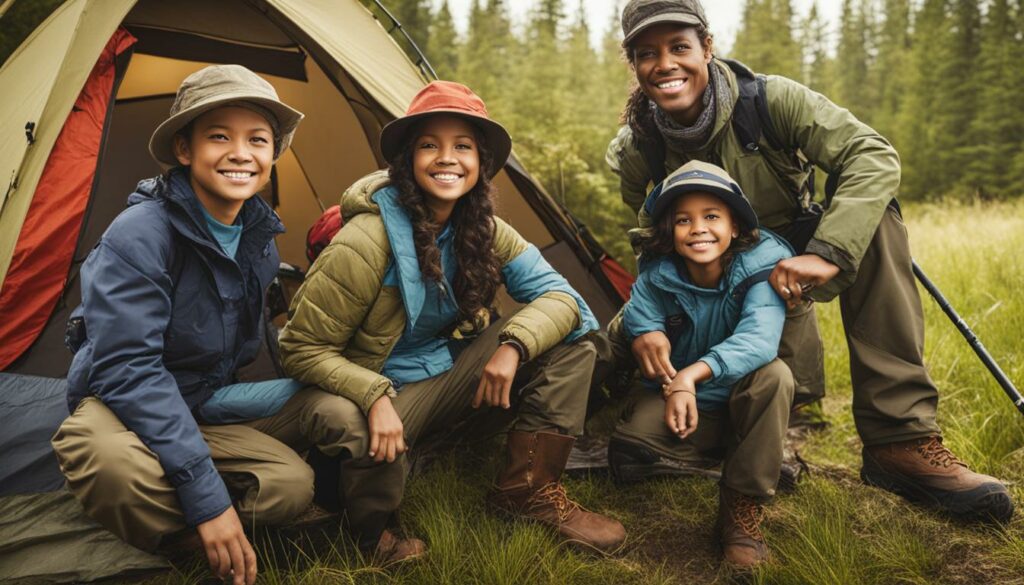
With the right clothing and footwear, you can fully enjoy your camping adventure, no matter the weather or activity. Remember to pack a variety of layered clothing, choose appropriate footwear, and consider the weather conditions of your destination. By dressing efficiently, you can focus on exploring the great outdoors and creating unforgettable memories.
Take Care of Health and Hygiene
When camping, it’s important to prioritize our health and hygiene to ensure a comfortable and safe experience. Here are some essential tips and items to pack:
- Bring a camping first aid kit containing band-aids, antiseptic wipes, pain relievers, and any necessary prescription medications. It’s always better to be prepared for any minor injuries or illnesses that may occur during your trip.
- Don’t forget to pack camping toiletries such as toothbrush, toothpaste, soap, shampoo, and toilet paper. These items are essential for maintaining personal cleanliness and comfort.
- Camping hygiene is crucial to prevent the spread of bacteria and illness. Remember to wash your hands frequently with soap and water, especially before handling food or eating.
- Protect yourself from the sun’s harmful rays by applying sunscreen regularly. Choose a broad-spectrum sunscreen with a high SPF and reapply every two hours, or more frequently if you are sweating or swimming.
- Insect repellent is a must-have item to keep pesky bugs and mosquitoes at bay. Opt for a repellent that contains DEET or other proven ingredients to ensure maximum effectiveness.
By taking care of our health and maintaining good hygiene practices, we can enjoy our camping trip to the fullest and minimize any potential discomfort or health risks.
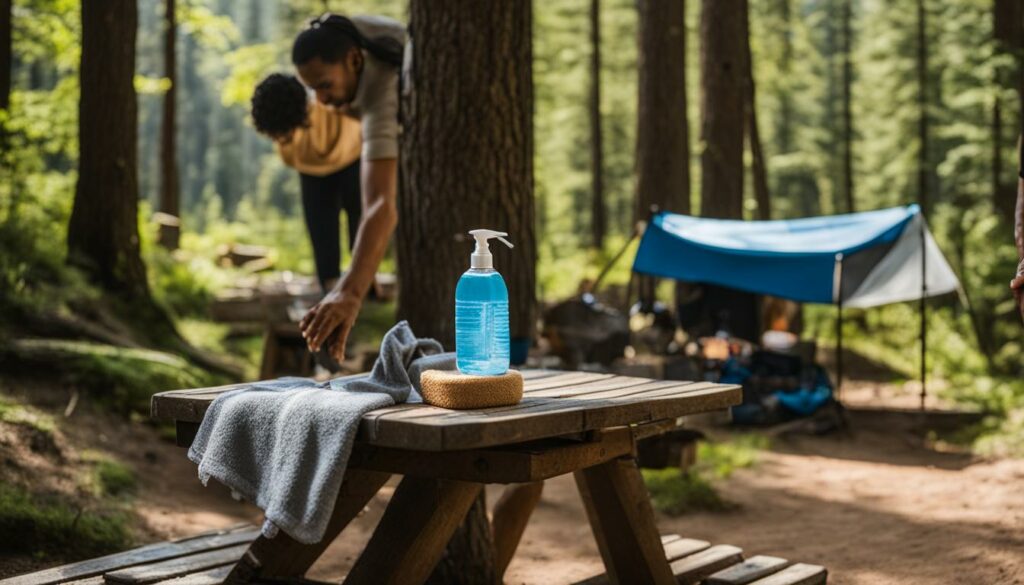
Make Your Camping Trip Fun and Memorable
When it comes to camping, it’s not just about enjoying the great outdoors, but also about having fun and creating lasting memories. To make your camping trip truly unforgettable, consider incorporating some entertaining activities and games into your itinerary. Here are a few ideas to get you started:
Campfire Games and Stories
No camping trip is complete without gathering around the campfire. Take advantage of this cozy setting by playing classic campfire games like charades, truth or dare, or the storytelling game. Share spooky ghost stories or personal anecdotes that will have everyone laughing and bonding.
Outdoor Adventures
Exploring the surrounding nature is an essential part of any camping trip. Plan outdoor activities that suit your interests and location, such as hiking, fishing, or kayaking. These adventures will not only keep you entertained but also allow you to appreciate the beauty of the outdoors.
| Activity | Equipment Needed |
|---|---|
| Hiking | Comfortable shoes, water bottle, backpack |
| Fishing | Fishing rods, bait, fishing license |
| Kayaking | Kayak, paddle, life jacket |
Board Games and Card Games
For those times when you want to relax at your campsite, bring along a selection of board games or card games. Playing games like Monopoly, Uno, or a deck of cards can provide hours of entertainment and friendly competition for everyone in your group.
Remember, the goal of these activities is to have fun and make memories with your family and friends. Embrace the spirit of adventure and take advantage of the outdoor setting to create experiences that will stay with you long after the camping trip is over.
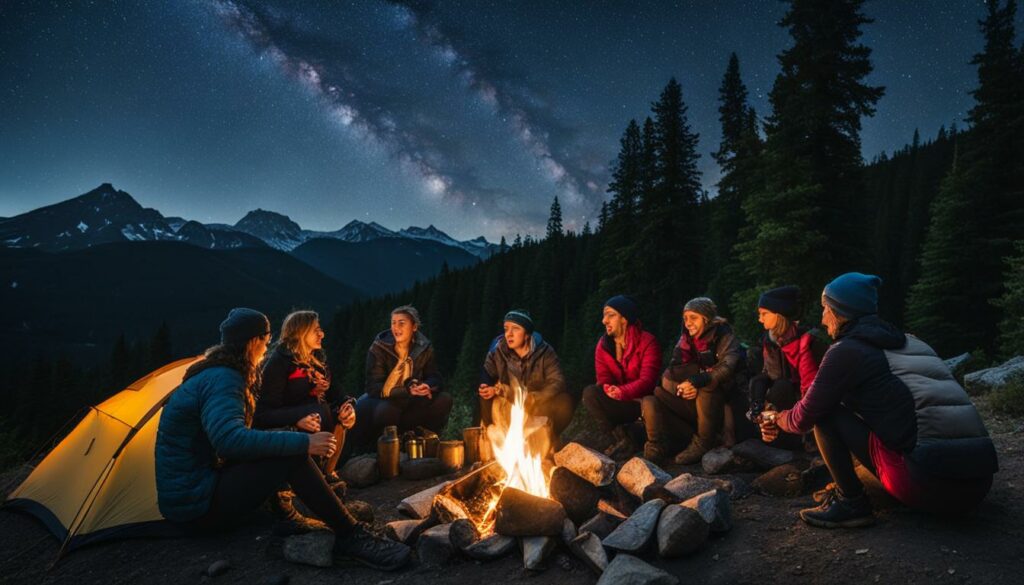
Follow Camping Etiquette and Leave No Trace
When enjoying the great outdoors, it’s important for us to practice camping etiquette and minimize our environmental impact. By following these principles, we can preserve the beauty of nature and ensure that future generations can also enjoy the wonders of camping.
One of the key aspects of camping etiquette is to leave no trace. This means cleaning up after ourselves and leaving the campsite as we found it. It’s important to dispose of trash properly, using designated bins or packing it out if necessary. We should also avoid damaging or disturbing natural resources such as plants, trees, and wildlife. By being mindful of our surroundings, we can protect the delicate balance of the ecosystem.
To further minimize our environmental impact, it’s essential to use camping gear and equipment responsibly. This includes using biodegradable and eco-friendly products whenever possible. We should also conserve water by using it sparingly and not polluting natural water sources. Additionally, we can reduce our carbon footprint by choosing energy-efficient camping gear and transportation options.
By practicing camping etiquette and leaving no trace, we can ensure that our camping trips are not only enjoyable but also sustainable. Let’s all do our part to protect and preserve the beauty of nature for future generations.
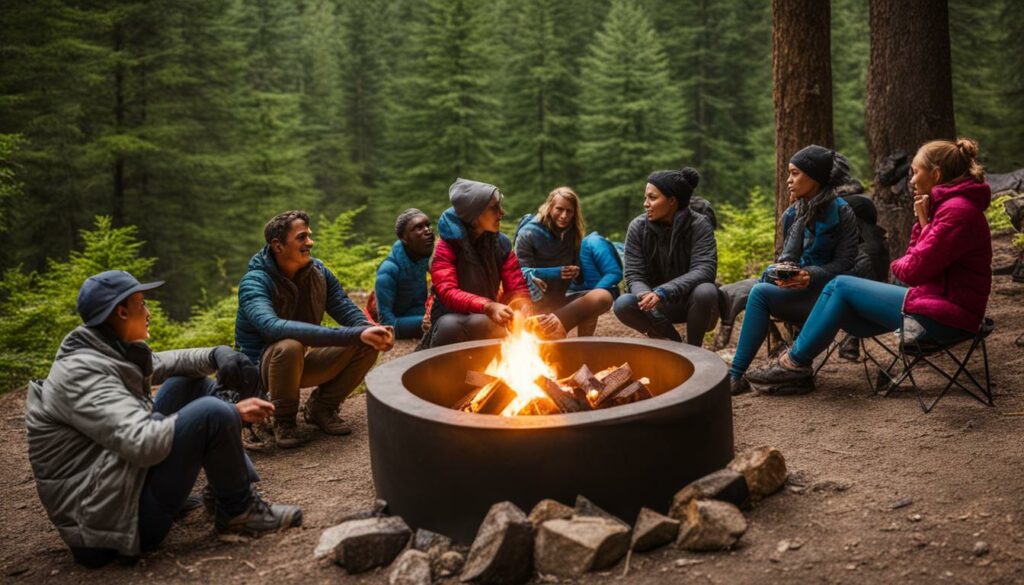
Benefits of Camping Etiquette and Leave No Trace
- Promotes environmental stewardship
- Preserves natural resources and habitats
- Creates a clean and safe camping environment
- Allows future generations to enjoy camping
- Reduces our carbon footprint
Consider Volunteering as a Camping Experience
Looking for a unique and fulfilling camping experience? Consider volunteering at campsites around the world. Not only will you have the opportunity to connect with nature, but you’ll also be able to make a positive impact in local communities.
Volunteer travel, also known as voluntourism, allows you to explore different destinations while contributing to meaningful projects. By exchanging work for accommodation, you can support campsites and organizations that promote sustainable and responsible tourism.
There are various volunteer opportunities available for camping enthusiasts. You can assist with campsite maintenance, help organize outdoor activities, or even participate in conservation projects to protect the natural environment. Volunteering as a camper opens up a world of possibilities and allows you to dive deeper into the camping experience.
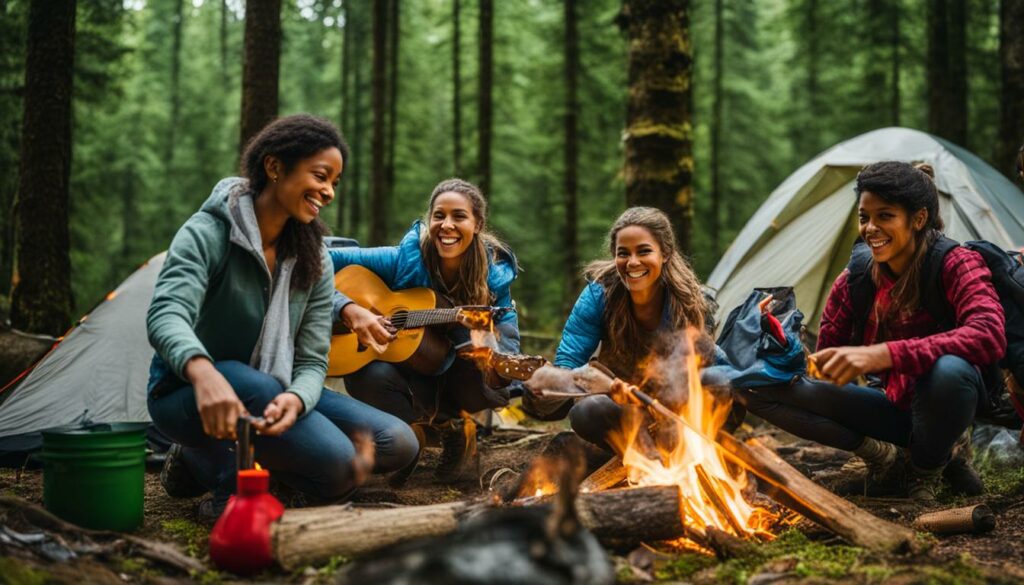
Example Volunteer Experience: Appalachian Trail Maintenance
“Volunteering on the Appalachian Trail was a life-changing experience. I spent a week camping in the beautiful wilderness, working on trail maintenance and meeting like-minded individuals who shared my passion for the outdoors. It was incredibly rewarding to contribute to the preservation of such a historic and scenic trail. I highly recommend volunteering as a way to enhance your camping adventures!”
So why not step outside your comfort zone and embark on a camping journey that combines adventure with giving back? Explore volunteer opportunities in your desired camping destinations and create memories that will last a lifetime.
Find the Perfect Campsite for Your Adventure
Choosing the right campsite is crucial for a successful camping trip. The location sets the tone for your entire outdoor adventure, so it’s important to consider various factors before making a decision. Whether you prefer a secluded wilderness experience or a campsite with amenities and facilities, there are plenty of options available to suit your preferences.
When researching camping destinations, take into account the type of activities you want to engage in during your trip. Are you looking for hiking trails, fishing opportunities, or access to water sports? Consider the natural surroundings and recreational opportunities offered by different campsites to align with your interests.
Additionally, read reviews and gather information about the campsite’s facilities and amenities. Some campgrounds provide access to clean restrooms, showers, and even laundry facilities, while others may have picnic areas, playgrounds, or swimming pools. Depending on your needs and preferences, these amenities can enhance your camping experience and make your stay more comfortable.
| Campsite | Location | Amenities | Activities |
|---|---|---|---|
| Wilderness Campsite | Remote forest | Minimal amenities | Hiking, wildlife spotting |
| Family-Friendly Campground | Near a lake | Restrooms, showers, playground | Fishing, kayaking, swimming |
| RV Park | Accessible by road | Full hookups (water, electricity) | RV camping, campfire cooking |
Remember to check for any special regulations or permits required for camping in the area you choose. Some locations may have specific rules regarding campfires, wildlife encounters, or noise levels. Being aware of these guidelines helps ensure a smooth and respectful camping experience for both you and the environment.
By taking the time to research and select the perfect campsite for your adventure, you can optimize your camping experience and create lasting memories in the great outdoors.
Prepare for Your First Camping Trip
If you’re embarking on your first camping trip, congratulations! Camping is a fantastic way to reconnect with nature and create lasting memories. To ensure your first camping experience is a success, it’s important to be well-prepared. Here are some essential tips for beginners:
Pick the Right Destination
Choosing the right camping location is crucial for a memorable trip. Research different campgrounds and consider factors such as proximity to amenities, available facilities, and the type of environment you prefer. Whether you opt for a national park, a beachside campground, or a secluded forest setting, make sure it aligns with your preferences and offers the activities and scenery you desire.
Get Familiar with Your Camping Gear
Before heading out on your camping adventure, take the time to familiarize yourself with your camping gear. Practice setting up your tent, assembling your camping stove, and using any other equipment you plan to bring along. This will not only help you feel more confident during your trip but also ensure that you’re well-prepared to handle any unexpected challenges that may arise.

Create a Detailed Packing List
One of the keys to a successful camping trip is being well-prepared with the right gear and supplies. Create a detailed packing list that includes essentials such as a tent, sleeping bags, camping chairs, cooking utensils, a first aid kit, insect repellent, and plenty of food and water. Don’t forget to pack appropriate clothing, including layers for different weather conditions. Having a comprehensive packing list will ensure that you don’t forget any important items and have a comfortable camping experience.
Plan Simple and Easy Meals
Cooking while camping doesn’t have to be complicated. Plan simple and easy-to-make meals that require minimal preparation and cook time. Opt for ingredients that are easy to store and don’t require refrigeration. Consider prepping some meals at home and freezing them, so they stay fresh longer. And don’t forget to pack plenty of snacks to keep you fueled throughout your camping adventure.
By following these tips, you’ll be well-prepared for your first camping trip and set yourself up for a fun and enjoyable outdoor adventure. Remember to pack responsibly, respect the natural environment, and embrace the beauty of nature. Happy camping!
Conclusion
Camping is a truly remarkable experience that allows us to connect with nature and create unforgettable memories. By implementing these essential camping tips and being well-prepared, we can ensure a successful and enjoyable outdoor adventure.
Remember, it is crucial to embrace the beauty of nature and respect our surroundings. Practicing camping etiquette and leaving no trace behind helps us minimize our environmental impact and preserve the natural environment for future generations to enjoy. Let’s be responsible campers and clean up after ourselves.
Whether you are a first-time camper or a seasoned outdoor enthusiast, proper planning and preparation are key to a successful trip. Research your destination, familiarize yourself with camping gear, and create a comprehensive packing list. Take the time to learn how to set up your equipment properly before you embark on your adventure.
So, grab your camping gear, gather your loved ones, and head out into the great outdoors. Enjoy the simplicity of a crackling campfire, the soothing sounds of nature, and the breathtaking landscapes. Camping allows us to disconnect from our busy lives and reconnect with what truly matters. Happy camping!
Can Properly Hooking Up a Camper Battery Enhance My Camping Experience?
Properly hooking up your camper battery can greatly enhance your camping experience. With a reliable power source, you can enjoy uninterrupted electricity for your appliances and devices, ensuring a more comfortable and convenient outdoor adventure. Don’t overlook the importance of a secure hook up camper battery for a hassle-free camping trip.
FAQ
How do I start planning for a camping trip?
Start planning and preparing at least a week before your trip. Create a checklist of essential camping gear and make sure everything is packed and ready to go.
What should I bring for a comfortable sleep while camping?
Bring a high-quality tent, sleeping bags, and sleeping pads or cots to ensure a comfortable and restful night’s sleep.
What cooking gear should I pack for camping?
Pack essential camping cooking gear such as a camping stove, pots, and utensils. Don’t forget to bring delicious camping meals and easy recipes to enjoy during your trip.
What clothing and footwear should I pack for camping?
Bring appropriate layers, including warm jackets for evenings and hiking boots for exploring the wilderness.
How can I take care of my hygiene and health while camping?
Pack essential toiletries, sunscreen, insect repellent, and a first aid kit to ensure your well-being during the trip.
How can I add fun elements to my camping trip?
Consider bringing camping games, portable speakers, or outdoor activities like hiking or fishing to enjoy the great outdoors.
What camping etiquette should I follow?
Follow camping etiquette and minimize your environmental impact. Leave no trace by cleaning up after yourself and respecting the natural surroundings.
Is there a way to have a unique camping experience?
Consider volunteering at campsites around the world. Worldpackers offers opportunities to exchange work for accommodation, allowing you to connect with nature and local communities.
How do I choose the right campsite for my camping trip?
Research different destinations, read reviews, and consider the amenities and facilities available at each campsite to find the perfect fit for your adventure.
What should I do to prepare for my first camping trip?
Proper preparation is key. Research your destination, familiarize yourself with camping gear, and create a detailed packing list. Also, make sure to learn how to set up your equipment before the trip.
How can I ensure a successful and enjoyable camping trip?
By following these essential camping tips and being well-prepared, you can have a successful and enjoyable camping trip. Remember to embrace the beauty of nature, have fun, and leave no trace. Happy camping!

